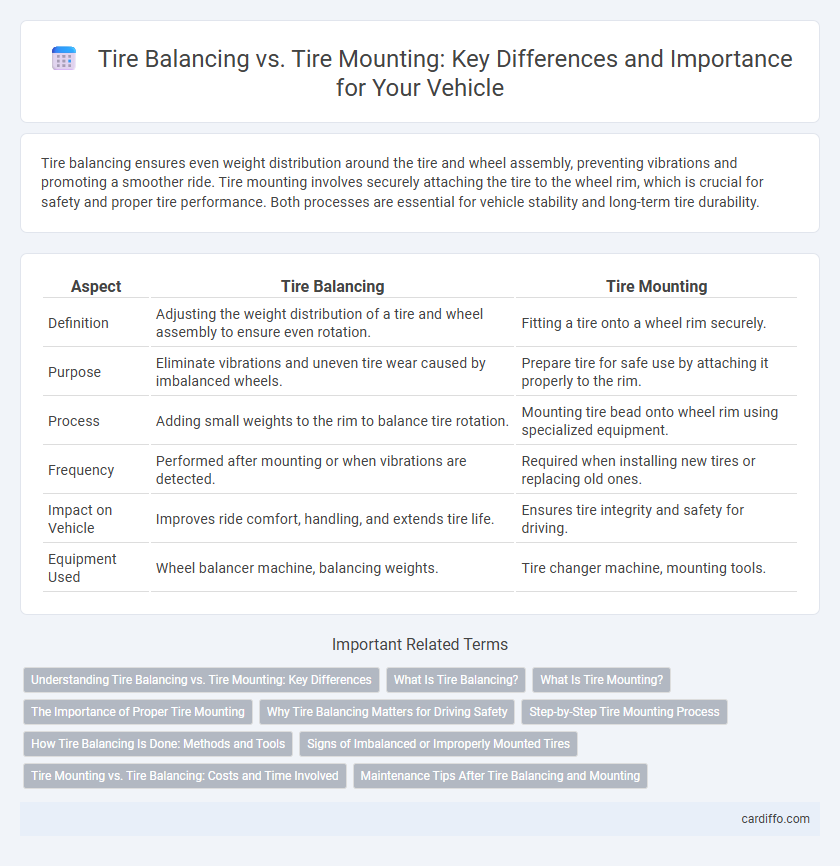Tire balancing ensures even weight distribution around the tire and wheel assembly, preventing vibrations and promoting a smoother ride. Tire mounting involves securely attaching the tire to the wheel rim, which is crucial for safety and proper tire performance. Both processes are essential for vehicle stability and long-term tire durability.
Table of Comparison
| Aspect | Tire Balancing | Tire Mounting |
|---|---|---|
| Definition | Adjusting the weight distribution of a tire and wheel assembly to ensure even rotation. | Fitting a tire onto a wheel rim securely. |
| Purpose | Eliminate vibrations and uneven tire wear caused by imbalanced wheels. | Prepare tire for safe use by attaching it properly to the rim. |
| Process | Adding small weights to the rim to balance tire rotation. | Mounting tire bead onto wheel rim using specialized equipment. |
| Frequency | Performed after mounting or when vibrations are detected. | Required when installing new tires or replacing old ones. |
| Impact on Vehicle | Improves ride comfort, handling, and extends tire life. | Ensures tire integrity and safety for driving. |
| Equipment Used | Wheel balancer machine, balancing weights. | Tire changer machine, mounting tools. |
Understanding Tire Balancing vs. Tire Mounting: Key Differences
Tire balancing ensures even weight distribution around the wheel to prevent vibrations and extend tire life, while tire mounting involves securely fitting the tire onto the wheel rim. Balancing uses weights to counteract imbalances detected by specialized machines, whereas mounting focuses on proper installation techniques to avoid damage and ensure safety. Understanding these distinct processes helps maintain optimal vehicle performance and tire longevity.
What Is Tire Balancing?
Tire balancing is the process of equalizing the weight distribution of a tire and wheel assembly to ensure smooth rotation and prevent vibrations. It involves attaching small weights to the rim to counteract heavy spots, improving ride comfort, tire wear, and vehicle handling. Unlike tire mounting, which is the installation of tires onto wheels, tire balancing addresses dynamic performance and safety during driving.
What Is Tire Mounting?
Tire mounting involves securely attaching a tire onto a vehicle's wheel rim, ensuring a proper fit and seal for optimal performance. This process requires specialized equipment to position the tire bead correctly on the rim without damaging the tire structure. Proper tire mounting is crucial for safety, maintaining tire integrity, and preventing issues like air leaks or uneven wear.
The Importance of Proper Tire Mounting
Proper tire mounting ensures the tire is securely fitted onto the wheel, preventing air leaks and reducing the risk of tire damage or blowouts. Improper mounting can lead to tire bead damage, uneven wear, and compromised vehicle safety. Tire balancing, while essential for smooth driving, cannot compensate for issues caused by incorrect mounting, highlighting the critical need for precise tire installation.
Why Tire Balancing Matters for Driving Safety
Tire balancing ensures even weight distribution around the tire and wheel assembly, preventing vibrations that can compromise vehicle control and cause uneven tire wear. Proper balancing enhances driving stability, reduces strain on suspension components, and improves overall safety by maintaining consistent traction. Neglecting tire balancing can lead to steering issues, increased tire deterioration, and a higher risk of accidents.
Step-by-Step Tire Mounting Process
Tire mounting involves securely fitting a tire onto a wheel rim to ensure proper alignment and safety, typically starting with inspecting the wheel and tire for damage. The process includes lubricating the tire bead, positioning the tire on the rim, and using specialized equipment to press the tire onto the wheel evenly. Proper tire mounting prevents uneven wear and improves vehicle performance, distinguishing it from tire balancing, which adjusts weight distribution after mounting.
How Tire Balancing Is Done: Methods and Tools
Tire balancing is performed by placing the tire and wheel assembly on a specialized balancing machine that spins it to identify heavy spots causing vibrations. Methods include bubble balancers, spin balancers, and dynamic balancers, with tools such as wheel weights applied to counterbalance imbalances detected during the process. Proper tire balancing enhances driving comfort, prolongs tire life, and improves fuel efficiency by ensuring even weight distribution.
Signs of Imbalanced or Improperly Mounted Tires
Signs of imbalanced tires include vibrations at higher speeds, uneven tire wear, and poor fuel efficiency, which indicate the need for precise wheel balancing to ensure optimal contact with the road. Improperly mounted tires often exhibit sidewall bulges, bead leaks, or air pressure loss, signaling incorrect installation that can compromise vehicle safety and performance. Regular inspection and professional tire mounting and balancing prevent uneven tread wear and ensure a smoother, safer driving experience.
Tire Mounting vs. Tire Balancing: Costs and Time Involved
Tire mounting involves securely fitting the tire onto the wheel rim, typically costing between $15 and $50 per tire and taking about 30 minutes for a full set. Tire balancing, which corrects weight distribution to prevent vibrations, generally costs $10 to $20 per tire and takes 15 to 30 minutes for all four tires. Understanding the distinct purposes and time requirements of tire mounting versus balancing helps optimize both budget and vehicle performance.
Maintenance Tips After Tire Balancing and Mounting
After tire balancing and mounting, regularly check tire pressure to ensure optimal performance and prevent uneven wear. Inspect the tires for any unusual vibrations or noises that could indicate improper balancing or mounting issues. Maintain proper wheel alignment and rotate tires every 5,000 to 7,000 miles to extend tire life and improve fuel efficiency.
Tire balancing vs Tire mounting Infographic

 cardiffo.com
cardiffo.com